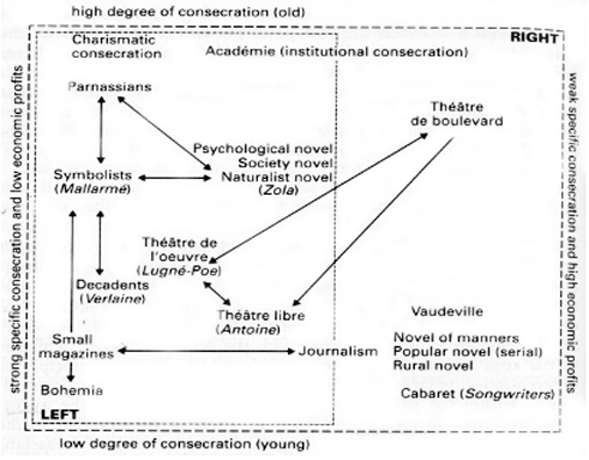On Wednesday the 10th November I attended a lecture given by Andrew Milner, Professor of Cultural Studies at Monash University, Melbourne in the Cypress building of the University of Liverpool. Although entitled 'from Flaubert to the Fantastique' the lecture was actually mostly about French sociologist, Pierre Bourdieu, and specifically his Les Règles de l'art. In Les Règles de l'art was a map which charted the positions of all of the current art of France giving it a relative location to all other forms of contemporary art. From left to right the items on the map increased in their profitibility and decreased in their 'art for art's sake' philosophy, meanwhile their vertical position was determined by their level of consecration, or how institutionalised they were. Here's an English translation of Bourdieu's map, I couldn't find a French one (such as the one Prof. Milner used in his demonstration) on the interweb:
Professor Milner proceeded to explain the original diagram in far better detail than I have above, before unveiling his remodelled version based, not on the French arts contemporary to Bourdieu, but on Science Fiction. Other changes made were that Bourdieu limited his diagram to only living influences (such as Zola in the centre), whilst Professor Milner expanded his to include artistes who have passed on, but who remain a "living influence" such as Philip K. Dick and J.G. Ballard, amongst others. Similarly, Bourdieu's diagram restrains itself to France alone whilst Professor Milner's reflects the multinational nature of modern movement such as Science Fiction and is global in its scope.
Being unable to provide a picture of Professor Milner's revised map there is little else I can do in this blog post except to attempt to draw a rough sketch of it in your mind's eye. Prof. Milner's map retained the three rough divisions of Poetry, Literature and Theatre that Bourdieu creates (in that order as vertical columns for left to right), expanding Theatre to encompass TV, film and radio, and including sf criticism such as Darko Suvin in the poetry category both because it makes a similar amount of money, and because there is so little sf poetry with which to flesh out the diagram.
Commercial TV occupied the bottom right corner, being the most populist, "all about the money" form of sf, and Gene Roddenberry was singled out as the exemplar of this movement. Above it came mainstream (ie. Hollywood) cinema moving up the map towards art-house cinema by people like Andrey Tarkovskiy. On the bottom left, occupying the role of Bohemia, was Ballard and Moorcock and New Worlds magazine, above them (though slightly more to the right and centre) was weird fiction as exemplified by China Miéville, before shooting back to the left (ie. the poor end) and the top with Darko Suvin-level critique. Zola's position as the dead centre of French culture was occupied by Wells and Verne and Scientific Romance. Below them were various sub-genres such as cyberpunk moving down to the pulps and championed by Hugo Gernsback. Above Wells and Verne were the American Feminist and Afrofuturist writers such as Le Guin and Delany with the top echelon of the novel being occupied by "literary" sf such as Orwell, Huxley et al.. A dotted line was drawn around literary sf, Darko Suvin and arthouse cinema which Professor Milner explained was a permeable barrier between sf and wider cultural movements. The things within the dashed line had crossed the barrier and been appropriated by wider society and thus no longer seen as sf by said community - or at least not tarred with the same brush - the nature of this barrier was interesting however, as Prof. Milner explained its one-way permeability as the sf community still involve it in their discussion and ideology, whilst mainstream communities prefer to ostracise it.
Overall it was an interesting lecture which felt much more like a "just throwing this out there" kind of a affair than the turgid affair genre theory can devolve into. I thought that Professor Milner's adoption and adaptation of Bourdieu's method of mapping had real potential as a method of thinking about the relationships of different forms of sf and their relationships with the social spheres of which they are a part. Of course the positioning of some of the elements is arguable, it's all based on conceptual ideas rather than formal numerical data, and some ideas could be expanded in a larger diagram but you have to stop somewhere or you could draw a map the size of the Liver Building and still be missing some of the details. One item, or possibly two, that I thought should have been on there but weren't were video games (which could possible be split up into commercial and indie) as they are valid narrative vehicles which can still be plotted on the map relative to the other items mentioned.
This is, however, a detail which doesn't detract from the usefulness of the model and I look forward to reading the full article in a forthcoming edition of Science Fiction Studies. One interesting exercise would be to overlay the map with another for Fantasy and Horror as they occupy similar spaces in the wider literary community, but their sub-genres and movements have as varied a relationship as sf.

No comments:
Post a Comment